Yarmouth and Gorleston Tramways
History
Powers to build a horse-drawn tramway between Yarmouth and Gorleston were granted on the 14th August 1871 under the East Anglian Tramway Order, which was passed into law via the Tramways Orders Confirmation Act, 1871.
Construction work on the standard-gauge tramway, which ran from South Town Station in Great Yarmouth to Feathers Plain in Gorleston, started in late 1872, a ceremonial plate laying taking place on the 14th October. Progress was, however, painfully slow, the official opening only taking place some two years later on the 25th March 1875. Although the reasons for this are a little unclear, it was possibly due to the involvement of the EATCo in a much more ambitious scheme, driven by two other tramway companies, to build a 20-mile tramway between Great Yarmouth and Southwold. Ultimately, the scheme would fail, but probably not before it had consumed a good deal of the EATCo's time and energy.
The early history of the tramway is a little unclear, though it quickly passed through three sets of owners, all of them seemingly struggling to make the concern pay. The first of these was the EATCo, which only operated the tramway for a year before selling it to the Great Yarmouth Tramways Company (in April 1876), which in turn (in 1878) sold it to the newly formed Yarmouth and Gorleston Tramways Company. By 1881, however, this company was also in trouble, posting notice on the 14th June 1881 of its intention to appoint a liquidator, and to sell the concern to new owners. Although the Yarmouth and Gorleston Tramways Company was struck off the Companies Register on the 7th March 1882, the new owners appear to have registered a new company with the same name.
The new owners seem to have had the financial wherewithal to run the tramway properly, completely relaying the poorly constructed track (originally laid on longitudinal sleepers) in 1882, but to a narrower gauge of 3ft 6ins. It is unclear why the gauge was altered, though it was possibly with one eye on double-track operation within narrow streets. The new company also acquired powers for a southwards extension of the tramway, these being obtained on the 2nd August 1883 under the Yarmouth and Gorleston Extension Order (1883), which was authorised via the Tramways Orders Confirmation (No. 3) Act, 1883. At this time, the system was operated by a fleet of ten horse trams.
The tramway was duly extended southwards in 1884 and 1886, and again in 1897, the latter under powers obtained on the 6th August 1897 (the Yarmouth and Gorleston Tramways Extension Order, 1897), which was authorised via the Tramways Orders Confirmation (No. 3) Act, 1897. This took the tramway to its final size of 2.75 miles. The tramway was essentially a long single line with passing loops, starting at the Great Eastern Railway's Yarmouth South Town Station, running southwards along Southdown Road, Gorleston High Street and Lowestoft Road, where it turned eastwards along Englands Lane to a terminus outside the King William IV public house on the River Yare quayside.
The tramway seems to have led a relatively uneventful life until the turn of the century when its peace was disturbed by the British Electric Traction Company, which was, during the late 1890s and early 1900s, embarking on a journey that would see it become a major player in the tramway world. It began by purchasing horse and steam-operated tramways across the British Isles with the intention of converting them to electric traction, as well as promoting schemes for completely new electric tramways, and was destined to own, part-own or lease over 50 tramway concerns across the United Kingdom.
The BETCo gained a controlling interest in the tramway company in 1900, and then set up a subsidiary — the Great Yarmouth and District Tramways Company — to acquire the necessary powers to convert the tramway to electric traction, and to construct and operate it. The BETCo presumably hoped to persuade Great Yarmouth Corporation, which already held powers to build an electric tramway within the town, to support its scheme, or failing that, to lease it the proposed municipal electric tramway. Although the corporation blocked all attempts by the BETCo to acquire its own powers, there was considerable opposition within the council to the concept of a municipally operated tramway, a campaign that ultimately failed by just a single vote. Construction of the municipal system started on the 16th October 1901, electric services commencing eight months later on the 20th June 1902.
With the corporation system up and running, there was little more that the BETCo could do other than operate the horse tramway until such time as the corporation wished to take it over, and to then obtain the best price possible. The BETCo quickly wound up its new subsidiary, the Great Yarmouth and District Tramways Company, the comp[any being struck off the Companies Register on the 16th August 1901.
Under the Tramways Act of 1870, as well as the Yarmouth and Gorleston Tramways Extension Order of 1897, the corporation was entitled to compulsorily purchase the horse tramway within six months after the 23rd August 1904. The corporation duly obtained powers to take over the tramway and convert it to overhead electric traction; these were granted on the 15th August 1904 under the Great Yarmouth Corporation Act, 1904.
An agreement was eventually reached between the corporation and the company, the former taking ownership of the horse tramway on the 12th March 1905, after which conversion to electric traction commenced. It is likely that the BETCo continued to operate the horse trams for a further four months, the last horse service running on the 4th July 1905, the same day that electric services commenced.
Uniforms
All that has survived from the very earliest days of the tramway, i.e., under the aegis of either the East Anglian Tramway Company or the Great Yarmouth Tramways Company, is a pencil drawing of the opening day (not shown); although far from clear, it suggests that crews wore informal attire.
Photographs taken during the era of the Yarmouth and Gorleston Tramways Company (1878 to 1900) are scarce, but those that have survived indicate that drivers and conductors wore robust but informal attire: shirt and jacket, and the horse tram driver's headgear of choice, the bowler hat. At some point, licence badges were issued — certainly to conductors, and possibly to drivers too — and these were suspended by a leather strap, either from a jacket button or the conductor's cash bag. They were quite large, broadly oval, and were almost certainly enamel; precise details are, however, unknown, as no examples appear to have survived.
At some point following the takeover by the British Electric Traction Company (in 1900), uniforms were issued; this was in fact quite unusual for the BETCo, as they almost always waited until the inauguration of electric services before issuing them, understandably given that their company device included a magnet and electrical flashes. I know of only two other examples where the BETCo issued uniforms to horsecar staff (Brighton and Shoreham Tramways and South Shields Tramways), and possibly a third (Gravesend, Rosherville and Northfleet Tramways). Uniform jackets were double-breasted with five pairs of buttons (of the standard BETCo pattern — see link) and lapels; the jacket collars probably bore embroidered system initials, though these cannot be made out on surviving photographs. Caps were soft-topped with a glossy peak and bore the standard BETCo 'Magnet and Wheel' cap badge (almost certainly in brass), beneath which was an employee number.
Photographs taken following the acquisition of the horse tramway by the corporation (12th March 1905), clearly show that staff continued to wear uniforms, almost certainly those issued by the BETCo; whilst this would on the face of it seem a little odd, in all likelihood, BETCo continued to operate the horsecars under a contract arrangement until the closure of the system barely four months later. Photographs taken during this time show drivers and conductors wearing small round licence badges — these were almost certainly the same enamel licence badges issued by the corporation to its own electric tramcar staff.
The Yarmouth and Gorleston Tramways Company certainly employed the services of an inspector, though whether he wore a uniform or not is unknown, as photographs do not appear to have survived.
Further reading
For a history of the horse tramway see: 'The Tramways of East Anglia — Chapter 3' by R C Anderson; The Light Railway Transport League (1969).
Images
Horse tram drivers and conductors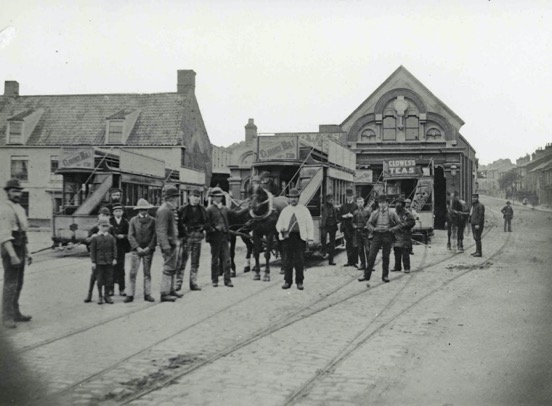
A busy and fairly early scene taken outside the tram depot at Feathers Plain, Gorleston (built in 1882) — photo undated, but from the style of the hats, almost certainly taken in the mid-1880s. Photo courtesy of the National Tramway Museum.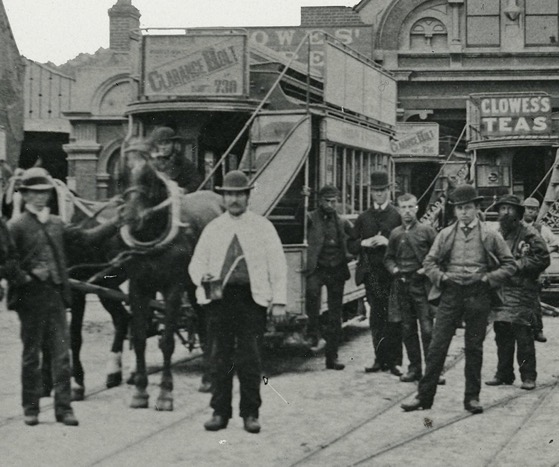
An enlargement of the above photograph showing the individuals immediately in front and to the right-hand side of the central tram. It is unclear who is and is not a tramway company employee, though what is clear, is that all are wearing informal attire, suggesting that uniforms were not worn.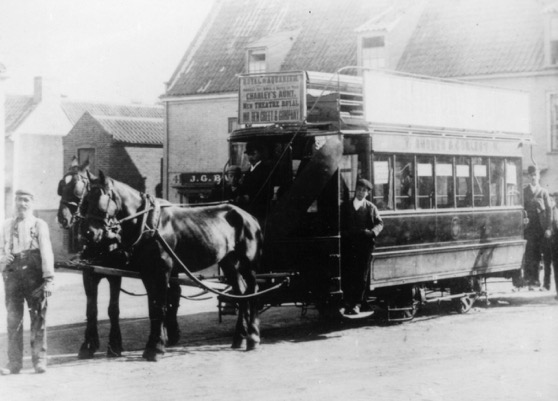
An unidentified Yarmouth and Gorleston horse tram stands at Feathers Plain in Gorleston — photo undated, but almost certainly taken around the turn of the century. Photo courtesy of the Tramways and Light Railway Society, with thanks to David Voice.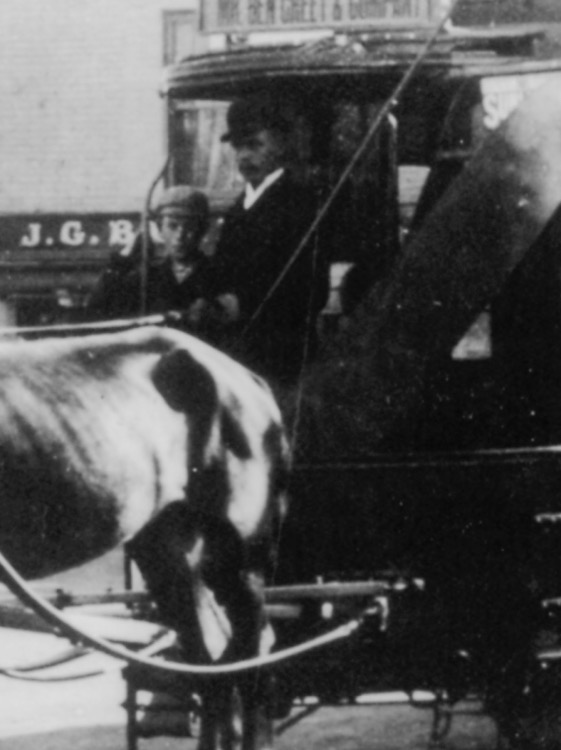
An enlargement of the above photograph showing the driver, who is clearly wearing informal attire, including the horse-tram driver's favoured headgear, the bowler hat.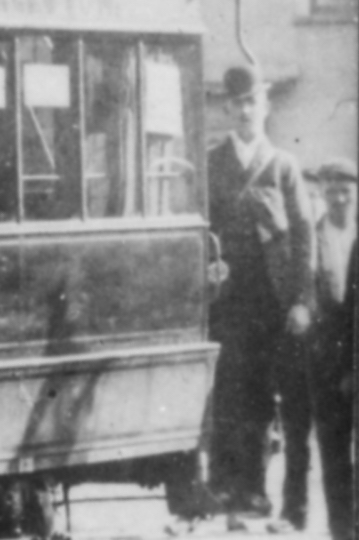
Another blow-up of the above photograph, this time showing the conductor, who has a large oval licence badge dangling from his cash bag, but who is otherwise informally attired.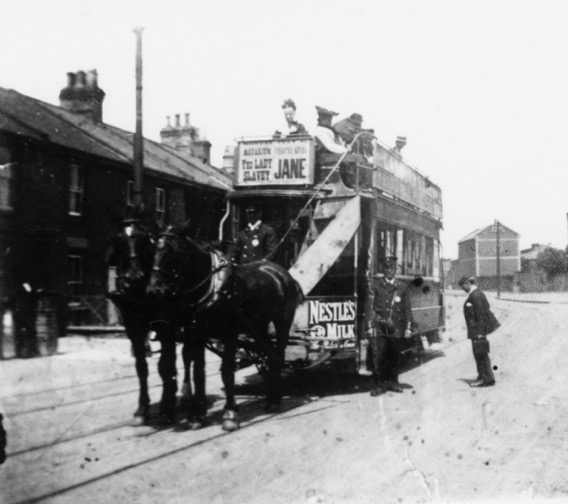
A driver and a conductor pose for the camera at Halfway House — photo undated, but very probably taken in the last couple of months of horse operation (June/July 1905) after the corporation had bought the company out. Photo courtesy of the Tramways and Light Railway Society, with thanks to David Voice.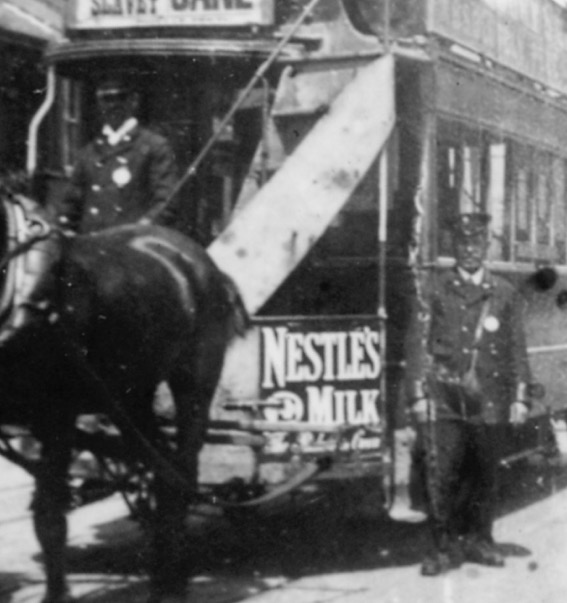
An enlargement of the above photograph showing the crew, both of whom are wearing uniforms with small round licence badges. The cap badge is probably a British Electric Traction Company 'Magnet & Wheel' issue, as it would seem that crews continued to wear BETCo uniforms right up until closure.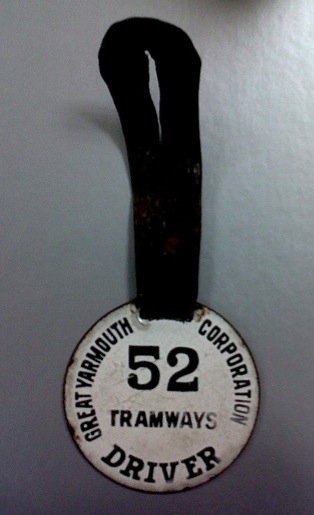
Great Yarmouth Corporation Tramways licence badge — black and white enamel. These were probably issued to staff following the corporation take-over. With thanks to the National Tramway Museum.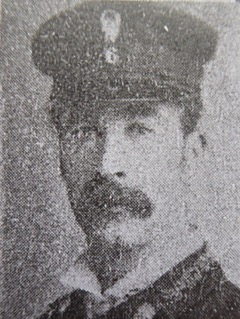
A copy of a press cutting of Y & GTCo Employee No 6 (J Thurston), presumably taken between 1900 and 1905. Although of poor quality, it nevertheless clearly shows that staff working the horse tram services wore caps bearing the standard BETCo 'Magnet & Wheel' device. Photo courtesy of the David Mackley Collection.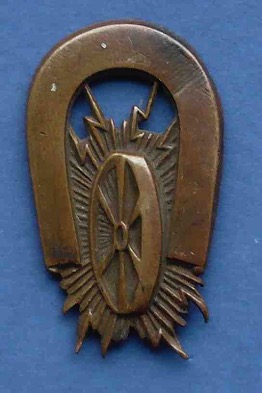
Standard British Electric Traction Company ‘Magnet & Wheel’ cap badge of the type worn by Yarmouth and Gorleston Tramways in the last five years or so of its existence — brass. Author's Collection.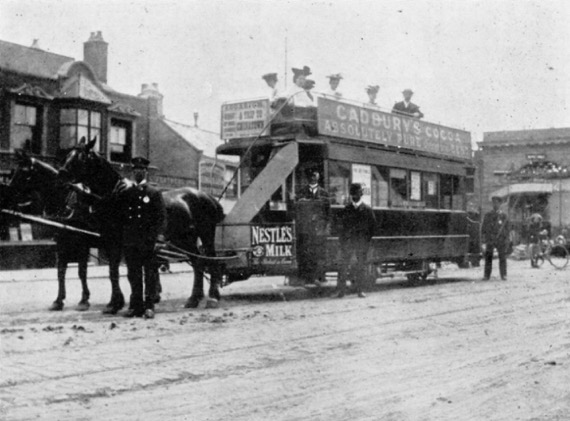
Another photograph of what is probably the same horsecar depicted in the Halfway House shot above, but one which is known to have been taken in June 1905 (at Feathers Plain), so definitely during the months of corporation ownership. All the tramway staff are wearing what would appear to be BETCo uniforms. Photo courtesy of the Tramways and Light Railway Society, with thanks to David Voice.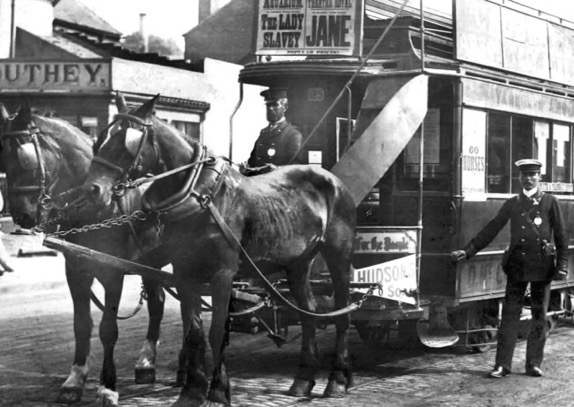
A shot taken in the last week or so of operation (July 1905), once again at Feathers Plain.